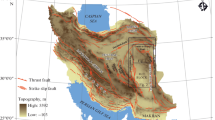Abstract
We calculate static stress change due to the 2005 Kashmir earthquake (M = 7.6). We suggest that the earthquake caused significant increase in stress in the Indo-Kohistan seismic zone (IKSZ) region, lying to the NW of the rupture and moderate increase in the adjacent Himalayan region, lying to the SE of rupture. Thus, these regions have been brought closer to the failure. On the other hand, the Salt Range region lies in the stress shadow of the earthquake, implying that future earthquakes in this region will be inhibited. We find that this earthquake may not be compared with typical Himalayan earthquake, and hence, rupture features of this earthquake may not be directly applicable to the earthquakes of the Himalayan region.
Similar content being viewed by others
References
Ambraseys N, Douglas J (2004) Magnitude calibration of north Indian earthquakes. Geophys J Int 159:165–206
Ambraseys N, Jackson D (2003) A note on early earthquakes in northern India and southern Tibet. Curr Sci 84:571–582
Armbruster J, Seeber L, Jacob KH (1978) The northwestern termination of the Himalayan mountain front: active tectonics from microearthquakes. J Geophys Res 83:269–282
Avouac JP, Ayoub F, Leprince S, Konca O, Helmberger DV (2006) The 2005, Mw 7.6 Kashmir earthquake: sub-pixel correlation of ASTER images and seismic waveforms analysis. Earth Planet Sci Lett 249:516–528
Baker DM, Lillie RJ, Yeats RS, Johnson GD, Yousuf M, Zamin ASH (1988) Development of the Himalayan frontal thrust zone: Salt Range, Pakistan. Geology 16:3–7
Bendick R, Bilham R, Khan MA, Khan SF (2007) Slip on an active wedge thrust from geodetic observations of the 8 October 2005 Kashmir earthquake. Geology 35:267–270
Bilham R (2004) Earthquakes in India and the Himalaya: tectonics, geodesy and history. Ann Geophys 47:839–858
Bilham R, Ambraseys N (2005) Apparent Himalayan slip deficit from the summation of seismic moments for Himalayan earthquakes, 1500–2000. Curr Sci 88:1658–1663
Bilham R, England P (2001) Plateau pop-up during the great 1897 Assam earthquake. Nature 410:806–809
Gahalaut VK (2006) 2005 Kashmir earthquake: not a Kashmir Himalaya seismic gap event. Curr Sci 90:507–508
Gahalaut VK, Chander R (1999) Geodetic evidence for accumulation of earthquake generating strains in the NW Himalaya near 75.5E longitude. Bulletin Seismological Society of America 89:837–843
Gahalaut VK, Kalpna (2001) Himalayan mid crustal ramp. Curr Sci 81:1641–1646
Gornitz V, Seeber L (1981) Morphotectonic analysis of the Hazara arc region of the Himalaya, north Pakistan and northwest India. Tectonophysics 74:263–282
Harris R (1998) Introduction to special section: stress triggers, stress shadows, and implications for seismic hazard. J Geophys Res 103:24347–24358
Kaneda H, Nakata T, Tsutsumi H, Kondo H, Sugito N, Awata Y, Akhtar SS, Majid A, Khattak W, Awan AA, Yeats RS (2006) Surface rupture of the 2005 Kashmir, Pakistan, earthquake and its active tectonic implications, American Geophysical Union, Fall Meeting 2006, Abstract #T31G-05
King GCP, Cocco M (2000) Fault interaction by elastic stress changes: new clues from earthquake sequences. Adv Geophys 44:1–38
King GCP, Stein RS, Lin J (1994) Static stress changes and the triggering of earthquakes. Bull Seismol Soc Am 84:935–953
Kumar S, Wesnousky SG, Rockwell TK, Briggs RW, Thakur VC, Jayangondaperumal R (2006) Paleoseismic evidence of great surface rupture earthquakes along the Indian Himalaya. J Geophys Res 111:B03304 DOI 10.1029/2004JB003309
Lavé J, Yule D, Sapkota S, Basant K, Madden C, Attal M, Pandey R (2005) Evidence for a great medieval earthquake (∼1100 A.D.) in the Central Himalayas, Nepal. Science 307:1302–1305
Molnar P (1990) A review of the seismicity and the rates of active underthrusting and deformation at the Himalaya. J Himal Geol 1:131–154
Nakata T, Tsutsumi H, Khan SH, Lawrence RD (1991) Active faults of Pakistan, map sheets and inventories, Spec. Publ. 21, 141 pp., Hiroshima Univ. Res. Cent. for Reg. Geogr., Hiroshima, Japan
Parsons T, Yeats RS, Yagi Y, Hussain A (2006) Hussain, Static stress change from the 8 October, 2005 M = 7.6 Kashmir earthquake. Geophys Res Lett 33:LO6304 DOI 10.1029/2005GL025429
Pathier E, Fielding EJ, Wright TJ, Walker R, Parsons BE, Hensley S (2006) Displacement field and slip distribution of the 2005 Kashmir earthquake from SAR imagery. Geophys Res Lett 33:L20310 DOI 10.1029/2006GL027193
Pennington WD (1979) A summary of field and seismic observations of the Pattan earthquake—28 December 1974. In: Farah A, DeJong KA (eds) Geodynamics of Pakistan. Geol. Surv. of Pakistan, Quetta, pp 143–147
Seeber L, Armbruster J (1979) Seismicity of the Hazara arc in northern Pakistan: decollement vs. basement faulting. In: Farah A, DeJong KA (eds) Geodynamics of Pakistan. Geol. Surv. of Pakistan, Quetta, pp 131–142
Seeber L, Armbruster AG (1981) Great detachment earthquakes along the Himalayan arc and long term forecasting. In: Earthquake prediction: an international review, Maurice Ewing Series 4, American Geophysical Union, Washington DC, pp 259–277
Seeber L, Armbruster JG, Quittmeyer RC (1981) Seismicity and continental subduction in the Himalayan arc. In: Zagros, Hindukush, Himalaya, Geodynamic Evolution, Geodynamic Series, Maurice Ewing Series 3, American Geophysical Union, Washington DC, pp 215–242
Stein RS, King GCP, Lin J (1994) Stress triggering of the 1994 M = 6.7 Northridge, California, earthquake by its predecessors. Science 265:1432–1435
Toda S, Stein RS, Reasenberg PA, Dieterich JH, Yoshida A (1998) Stress transferred by the 1995 Mw = 6.9 Kobe, Japan, shock: effect on aftershocks and future earthquake probabilities. J Geophys Res 103:24,543–24,565
Valdiya KS (1973) Tectonic framework of India: a review and interpretation of recent structural and tectonic studies. Geophys Res Bull 11:79–114
Yeats RS, Nakata T, Farah A, Fort M, Mirza MA, Pandey MR, Stein RS (1992) The Himalayan frontal fault system. Ann Tecton (supplement to v.) 6:85–98
Author information
Authors and Affiliations
Corresponding author
Additional information
This article has previously been published in issue 12/3, under 10.1007/s10950-008-9092-4.
Rights and permissions
About this article
Cite this article
Gahalaut, V.K. Coulomb stress change due to 2005 Kashmir earthquake and implications for future seismic hazards. J Seismol 13, 379–386 (2009). https://doi.org/10.1007/s10950-009-9169-8
Received:
Accepted:
Published:
Issue Date:
DOI: https://doi.org/10.1007/s10950-009-9169-8




